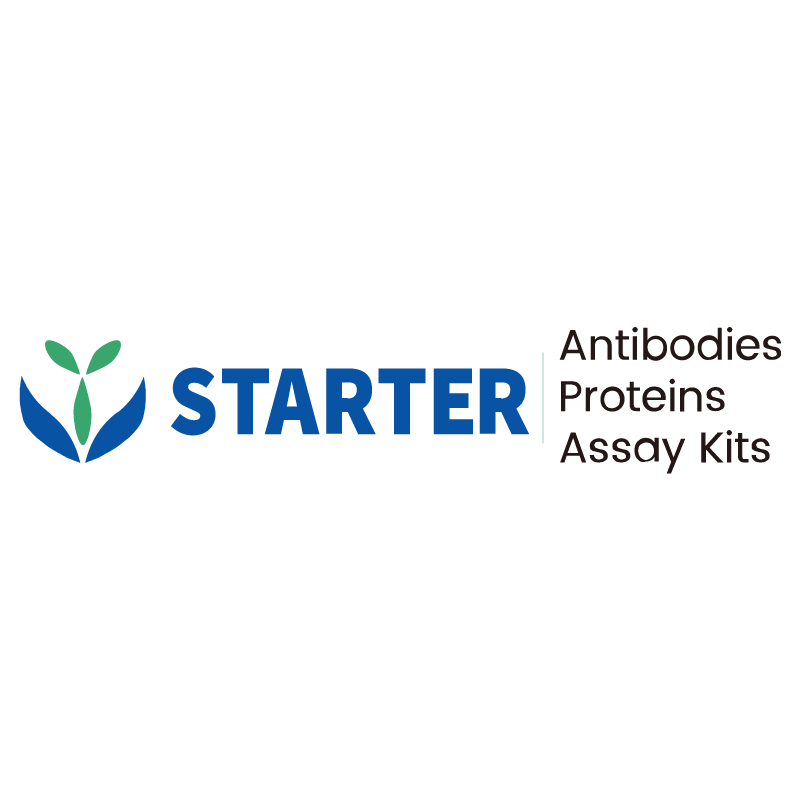WB result of ATP5A Recombinant Rabbit mAb
Primary antibody: ATP5A Recombinant Rabbit mAb at 1/1000 dilution
Lane 1: HeLa whole cell lysate 20 µg
Lane 2: HepG2 whole cell lysate 20 µg
Lane 3: Jurkat whole cell lysate 20 µg
Lane 4: A549 whole cell lysate 20 µg
Secondary antibody: Goat Anti-rabbit IgG, (H+L), HRP conjugated at 1/10000 dilution
Predicted MW: 60 kDa
Observed MW: 55 kDa
Product Details
Product Details
Product Specification
| Host | Rabbit |
| Antigen | ATP5A |
| Synonyms | ATP synthase subunit alpha, mitochondrial; ATP synthase F1 subunit alpha; ATP5F1A; ATP5A1; ATP5AL2; ATPM |
| Immunogen | Synthetic Peptide |
| Location | Mitochondrion, Cell membrane |
| Accession | P25705 |
| Clone Number | S-1542-211 |
| Antibody Type | Recombinant mAb |
| Isotype | IgG |
| Application | WB, IHC-P |
| Reactivity | Hu, Ms, Rt |
| Positive Sample | HeLa, HepG2, Jurkat, A549, Neruo-2a, PC-12 |
| Predicted Reactivity | Or, Pg, Bv, Fr, Ys, Nm |
| Purification | Protein A |
| Concentration | 0.5 mg/ml |
| Conjugation | Unconjugated |
| Physical Appearance | Liquid |
| Storage Buffer | PBS, 40% Glycerol, 0.05% BSA, 0.03% Proclin 300 |
| Stability & Storage | 12 months from date of receipt / reconstitution, -20 °C as supplied |
Dilution
| application | dilution | species |
| WB | 1:1000 | Hu, Ms, Rt |
| IHC-P | 1:1000 | Hu |
Background
ATP5A (ATP synthase F1 subunit alpha) is a key component of the mitochondrial ATP synthase complex, also known as Complex V or F1F0 ATP synthase, which is responsible for ATP production through oxidative phosphorylation. This enzyme complex consists of two major domains: the F1 catalytic core and the Fo membrane proton channel. ATP5A encodes the alpha subunit of the F1 domain, which is essential for ATP synthesis. It is ubiquitously expressed in various tissues, including the heart, kidney, and nervous system. In addition to its role in energy metabolism, ATP5A has been implicated in cancer progression. For example, it interacts with MTA1 (metastasis-associated protein 1) to drive mitochondrial metabolic reprogramming and enhance oxidative phosphorylation, thereby promoting liver metastasis in colorectal cancer. Overexpression of ATP5A has also been observed in metastatic lung adenocarcinomas, highlighting its potential role in tumor development. Defects in ATP5A1 have been linked to severe mitochondrial disorders, such as neonatal mitochondrial encephalopathy. Given its critical function in ATP synthesis and involvement in disease processes, ATP5A1 is an important target for understanding mitochondrial dysfunction and developing therapeutic strategies.
Picture
Picture
Western Blot
WB result of ATP5A Recombinant Rabbit mAb
Primary antibody: ATP5A Recombinant Rabbit mAb at 1/1000 dilution
Lane 1: Neuro-2a whole cell lysate 20 µg
Secondary antibody: Goat Anti-rabbit IgG, (H+L), HRP conjugated at 1/10000 dilution
Predicted MW: 60 kDa
Observed MW: 55 kDa
WB result of ATP5A Recombinant Rabbit mAb
Primary antibody: ATP5A Recombinant Rabbit mAb at 1/1000 dilution
Lane 1: PC-12 whole cell lysate 20 µg
Secondary antibody: Goat Anti-rabbit IgG, (H+L), HRP conjugated at 1/10000 dilution
Predicted MW: 60 kDa
Observed MW: 55 kDa
Immunohistochemistry
IHC shows positive staining in paraffin-embedded human liver. Anti-ATP5A antibody was used at 1/1000 dilution, followed by a HRP Polymer for Mouse & Rabbit IgG (ready to use). Counterstained with hematoxylin. Heat mediated antigen retrieval with Tris/EDTA buffer pH9.0 was performed before commencing with IHC staining protocol.
IHC shows positive staining in paraffin-embedded human kidney. Anti-ATP5A antibody was used at 1/1000 dilution, followed by a HRP Polymer for Mouse & Rabbit IgG (ready to use). Counterstained with hematoxylin. Heat mediated antigen retrieval with Tris/EDTA buffer pH9.0 was performed before commencing with IHC staining protocol.
IHC shows positive staining in paraffin-embedded human cardiac muscle. Anti-ATP5A antibody was used at 1/1000 dilution, followed by a HRP Polymer for Mouse & Rabbit IgG (ready to use). Counterstained with hematoxylin. Heat mediated antigen retrieval with Tris/EDTA buffer pH9.0 was performed before commencing with IHC staining protocol.
IHC shows positive staining in paraffin-embedded human hepatocellular carcinoma. Anti-ATP5A antibody was used at 1/1000 dilution, followed by a HRP Polymer for Mouse & Rabbit IgG (ready to use). Counterstained with hematoxylin. Heat mediated antigen retrieval with Tris/EDTA buffer pH9.0 was performed before commencing with IHC staining protocol.


